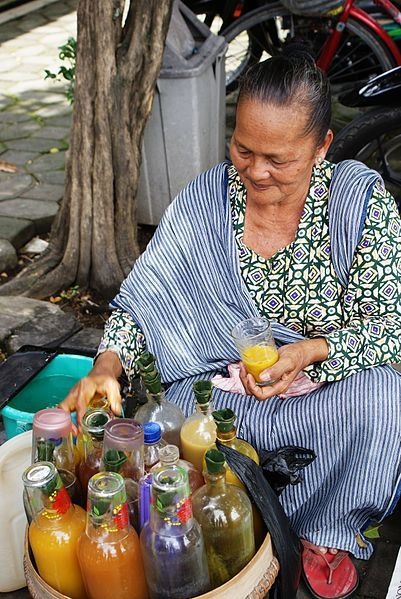Jamu is the name for the traditional medicine of Indonesia. Later, popularly known as the herb or herbs.
Herbal medicine made from natural materials, such as parts of plants such as rhizomes (roots), leaves, bark, and fruit. There is also the use of materials of animal body, such as bile goat, snake bile, or tangkur crocodile. Often chicken egg yolk is also used for an additional mix in carrying medicinal.
Jamu usually tasted bitter so need to be supplemented honey as a sweetener to taste more tolerable drinker. There's even a herbal medicine coupled with wine. Other than as a reduction of the bitter taste, the wine also serves to warm the body.
Sukoharjo [1] is a center of traditional herbal medicine sales are well known in Indonesia. Sukoharjo is one of the counties that are included in the Central Java province.
Of the many traditional herbal traders in Sukoharjo, it was established the identity of the statue is a statue of Herbal Wear Sukoharjo in Bulakrejo. Commonly called Herbal Wear statue because statue depicts a farmer and a herbalist carrying. Sukoharjo regions, particularly sub-district Nguter, is famous as the place of origin herbalist carry in many big cities, such as Jakarta, Bandung, Bogor, Surabaya.
In many big cities there are professional herbalist carrying itinerant peddling herbal medicine as a healthy and refreshing drink. Besides herbs are also produced in factories by major companies such as medicinal herbs Fountain, Nyonya Meneer or Djamu Djago, and sold at various drug stores in sachet packaging. Herbs such as this must be dissolved in hot water before drinking. In the further development of herbal medicine is also sold in the form of tablets, caplets and capsules.


Sales of the type and number of carrying medicinal varies greatly for each vender. It depends on the habits they learned from experience about what herbs are in demand as well as the order requested by the customer. Every day the number and types of herbs are sold is not always the same, depending on the habits and needs of consumers. After data collection [need citation needed], obtained information that the type commonly sold herbal medicine there are eight, ie kencur rice, chili puyang, kudu laos, key order, uyup-uyup / gepyokan, turmeric acid, pahitan, and sinom. Sometimes sellers carrying medicinal herbs also provide a powder or a pill and capsule production of herbal medicine industry.
If herbs are made using sweeteners, herbs maker will use brown sugar, granulated sugar, or sugar cubes (form large crystals resemble boulders). Use real sugar is a must for herbalist for health reasons. Herbs that use artificial sweeteners means that violate the rules and deviate from the goal of making herbal medicine, which is to nourish and maintain healthy weight.
Jamu herbal powder or powder packaging made dough clumps taken by way of brewed hot water or with other herbs by herbalist carrying. Brewing with other herbs not arbitrary. Jamu proper cough when mixed with herbal rice kencur. Herbal medicine is more precise stiff mixed with laos kudu, honey or egg yolk. While herbal sinom or turmeric acid mixed with lime as a refreshing taste.
.



